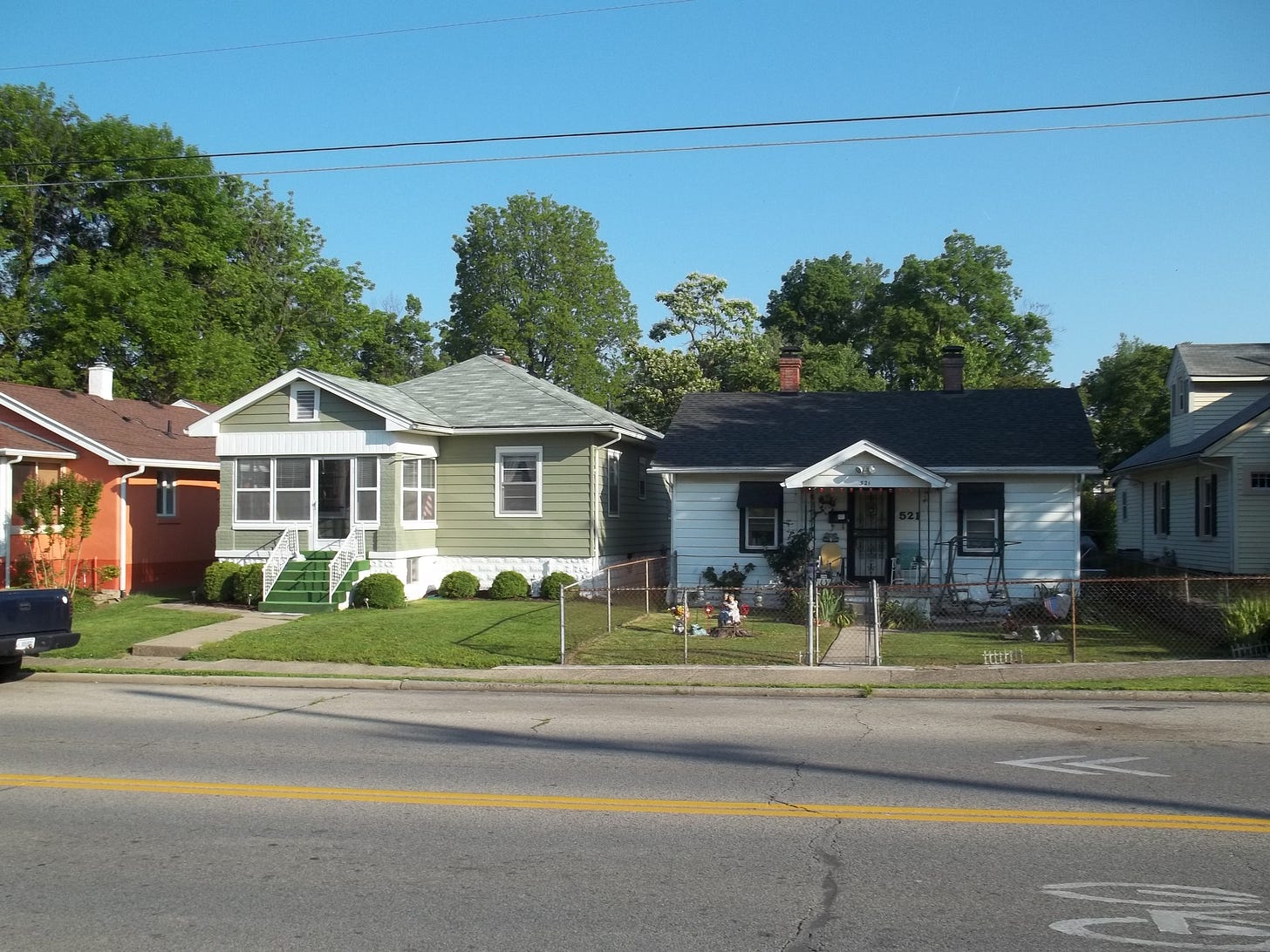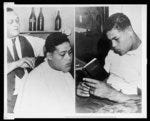A Boy's Life in the Great Depression, Part 1
A look at 9-year-old Ralph Sagebiel and his family before the flood.

JEFFERSONVILLE, INDIANA — The house at 521 East Market Street was snug because it was home to eight Sagebiels: Ralph, his parents Jim and Edna and baby brother Bruce; grandparents Adolph and Sallie; and Aunt Daro and Uncle Bill.
Ralph later called it a shotgun house.
“It was pretty much straight back,” although “it had rooms offset a little bit.”
A small entrance led into the living room, in which a leather couch pulled out into a bed for Uncle Bill. Furniture was scattered about the main room, including a piece that was central to family life.
“That’s where we all went together and listened to the radio,” Ralph said.
The Sagebiels owned an RCA Victor console radio, the most important piece of furniture in the small house, at least for Ralph. It was the golden age of radio, but no one in the household was thinking about that at the time.
Ralph listened to boxing matches —especially those involving heavyweight Joe Louis — baseball, dramas and comedies.
“Everyone wanted to see him get beat,” Ralph said about Louis. “He was a black man. But Joe was too good for everybody.”
There were three bedrooms. Ralph shared a bedroom with his parents and brother. His grandmother and Aunt Daro shared another bedroom.
“My grandfather and grandmother didn’t sleep together,” he said, “and I don’t know why. But he was big and had problems sleeping.”
Grandfather Adolph
Adolph, 85, had his own bedroom. Ralph recalled the time his grandfather was confined to that bedroom with double pneumonia.
“I remember him in that bed, and he was really sick, and he was hallucinating.” Adolph saw snakes on the wall and was “out of his head.” He was burning up with fever. The doctor came. “I don’t think he’ll make it through the night,” he said. “I don’t think he’ll be with us in the morning.”
Besides rest and perhaps aspirin, there was no way to treat Adolph, no penicillin or other wonder drugs that would come later. But the doctor’s prediction didn’t come true. The fever broke, the snakes vanished and Adolph pulled through.
Family members might not have been surprised. Adolph was a survivor, a man who had kept his wits to find his way out of the Alaskan wilderness after a snowstorm left him stranded. He had traveled there to build ships. He also may have worked as a shipbuilder in South America, according to his grandson.
Adolph’s rugged ways included avoiding dentistry. He pulled his own teeth, wrapping twine around them and wiggling them for days. He gummed his food because he didn’t bother to be fitted with false teeth.
When asked how his grandfather talked and sounded, Ralph, chuckling, said, “Like somebody with no teeth.”
Adolph was also overheard grunting loudly because he performed minor surgery in the bathroom. He removed a growth from his face with a knife.
“It was a carbuncle,” Ralph said.
Not Fancy
Toward the back of the house was a dining room with an oval-shaped wooden table at which the family ate supper. Beyond it was the kitchen, where Ralph’s grandmother and Aunt Daro prepared the meals. To the right was a bathroom and a pantry. An open porch anchored the rear of the house.
The home’s exterior was covered with wood clapboard siding.
“It wasn’t fancy.”
The Sagebiels’ next-door neighbors were Pat and Laura True to the west and the Trebings with a daughter named Rosalee to the east.
The home sat on a narrow lot that extended to a dirt alley connecting Watt Street and Meigs Avenue. The skinny, long backyard contained a shed that served as a workshop and storage for Adolph’s tools. The shed was also used to store coal that fueled stoves for cooking meals and warming the house.
Attached to the shed was a basketball goal, where Ralph’s father, uncles and their friends gathered to shoot hoops.
“I’d shoot underhanded and I couldn’t even get it up to the rim,” Ralph said about those early days. “But I’d go out there and keep trying.”
Chestnut Street School
Ralph attended Chestnut Street School, a three-story, yellowish-brick building that opened in 1870. The principal was Mr. Snodgrass, as he recalled.
“Mrs. McCoskey was my first grade teacher. I can’t remember [second grade]. My third was Schroeder. It was a good school.”
What wasn’t good for Ralph was the first-grade play. The thought of getting up in front of classmates terrified him.
“I actually worried until I made myself sick,” he said. “I couldn’t go to school and be in the play because I was sick.”
He added, “I was sort of scared of my shadow, and that followed me a long way.”
Aunt Daro
Learning and earning high marks came easily for Ralph. He credited his Aunt Daro, who had a high-school education and worked as a secretary for Dr. Ralph Bruner, another of Ralph’s uncles.
“[Aunt Daro] was almost like my mother,” Ralph said, “and my mother was like my sister.”
(Ralph’s mother was 15 when he was born. Her formal education was very limited.)
Aunt Daro taught him to read and count. Upon entering first grade, Ralph could count to 100 and knew the alphabet. He could read simple stories and spell simple words.
“That put me way ahead of the other kids, and I was able to stay ahead of them.”
His aunt gave him a steady supply of reading material, including stories in the “Big Little Books” series, and “Huck” Finn, Tom Sawyer, Penrod, and the Bobbsey Twins.
“I was reading all that stuff when I was really young. She made me love reading and school. And then I excelled in school — and that’s what I got praised for — so that encouraged me to keep doing well. It all goes back to her.”
There was a downside. Aunt Daro instilled too much caution in her impressionable nephew.
“She did a lot of good things, but instead of making me a tough boy, she was making me more like a girl.”
A Neighborhood Bully
One bad thing about school and the neighborhood was a boy named Wilbert who lived a block from Ralph. Two years older, Wilbert was a husky kid with a mean streak.
“[He would] run right up and shove me into whatever happened to be there, a bush or hedge,” Ralph said.
“He didn’t do it every day, but he did it for a time. I didn’t tell anybody. I didn’t like Wilbert very much. I tried to avoid Wilbert.”
Fortunately, there were at least a few ways to escape his boyhood concerns. One of those happy diversions was the Saturday matinee on Spring Street.
Start at the beginning of The 1937 Flood Journal or access the archives.
My Family in the Story
Ralph Sagebiel, father
Bill Sagebiel, great uncle
Daro Sagebiel, great aunt
Adolph Sagebiel, great grandfather
Other Sagebiels not mentioned by name
FRIED BOLOGNA: Family Stories from the American Midwest and Upland South Join me for stories about my ancestors who lived, worked and traveled in the hills and along the rivers of Arkansas, Illinois, Indiana, Iowa, Missouri and beyond.







Great work, Neil! I love your storytelling style and the way you weave facts and locations so seamlessly into the story - can't wait to read more about your family and the flood!